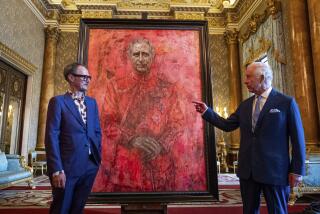Back to another age of celebrity
LONDON — The Regency was a turbulent time in Britain, when King George III was officially declared mad, his rascal of a son -- the prince of Wales -- held the throne and the country was at war with France.
But the Regency and the decades surrounding it also produced a flowering of the arts and breakthroughs in science and politics.
The country enjoyed Romantic poets such as William Wordsworth and Samuel Taylor Coleridge; major painters John Constable, J.M.W. Turner and William Blake; and inventors such as Edward Jenner, who created the smallpox vaccination.
Slavery was abolished in the British empire, and after more than a decade of costly war with France, the duke of Wellington defeated Napoleon Bonaparte at the Battle of Waterloo.
The Regency exhibition at the National Portrait Gallery in London focuses on the colorful life of the prince of Wales, who ruled as regent beginning in 1811, when his father was declared incapacitated by bouts of insanity. In 1820, when King George III died, his son succeeded him as King George IV.
But the permanent exhibition at the gallery also takes in developments in a much broader period, from 1785 to 1837. The gallery’s new multimedia approach brings the portraits and sculpture to life as never before.
The four galleries are divided into three themes -- “Royalty, Celebrity and Scandal,” “Art, Thought and Invention” and “The Road to Reform.”
The first theme focuses on the prince’s love life.
In 1785, he secretly married Roman Catholic widow Maria Anne Fitzherbert, one of the beauties of her day. But it was illegal for the heir to the throne to marry without the king’s permission, and the laws of day forbade the heir to marry a Catholic. So the marriage was ignored and George reluctantly married Princess Caroline of Brunswick in 1795. The relationship with Fitzherbert continued on and off for years.
The prince soon abandoned Caroline, “but with her good-natured vulgarity, coarseness of tongue and boisterous immorality, she was a thorn in her husband’s side for over 20 years, culminating in the scandalous ‘Trial of Queen Caroline’ in the House of Lords,” the museum says.
Throughout that time, “George had countless mistresses,” said Lucy Peltz, the show’s curator. In some ways, Peltz said, the Regency became the world’s first age of celebrity.
Viewers fascinated by the royal bad boy can view paintings of the king, Fitzherbert and Queen Caroline in the same room -- along with a computer that brings them to life with the touch of a finger.
The portrait of King George IV shows him proudly dressed in a general’s uniform, complete with a sword. The portrait of Fitzherbert, by Sir Joshua Reynolds, features her dressed in a formal gown.
But both works are dwarfed by the “Trial of Queen Caroline” painting, which was captured on a huge scale by Sir George Hayter. It shows a crowded House of Lords debating the king’s requested divorce, with some peers looking embarrassed and Queen Caroline furious.
Nearby, a museum computer allows viewers to magnify sections of the painting. Viewers also can get the name and background of each legislator, and learn how Hayter’s sympathetic painting was commissioned by the queen’s supporters.
Several computers in the four-room exhibition allow viewers to create their own narrative based on the artworks.
One computer section about the king -- “Miniatures as love tokens” -- shows the kind of gold locket he gave his mistresses, complete with his coat of arms on the front and his monogram on the back. Inside was a braided lock of his hair.
Nearby, one of his real lockets is shown in a glass container that shields the delicate artifact from natural light and a viewer’s touch. The electric light inside only goes on when a viewer approaches.
The National Portrait Gallery also gives viewers a free, newly designed Sound Guide to accompany the permanent Regency exhibition.
Other works in the show include the only certain portrait of author Jane Austen; a portrait of poet Lord Byron, in full Albanian dress; and paintings of William Blake, John Keats and Walter Scott.
Benjamin Robert Haydon’s monumental painting “The Anti-Slavery Society Convention, 1840” also is on display for the first time since 1985.
The exhibit’s four rooms have been redesigned by architect Piers Gough, with fine oak floors, black Belgian marble casements, blue-green silk wallcoverings and new windows that allow in more natural light.
The recent reopening of the National Portrait Gallery marks the completion of a 10-year program of refurbishment and redisplay, including the addition of the Ondaatje Wing, and the renovation of gallery spaces.
More to Read
The biggest entertainment stories
Get our big stories about Hollywood, film, television, music, arts, culture and more right in your inbox as soon as they publish.
You may occasionally receive promotional content from the Los Angeles Times.










